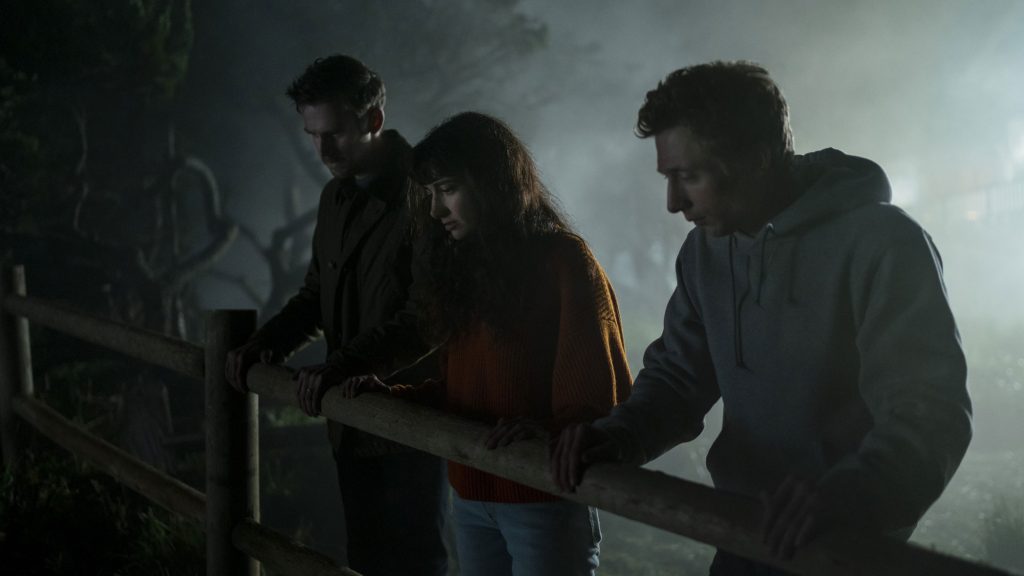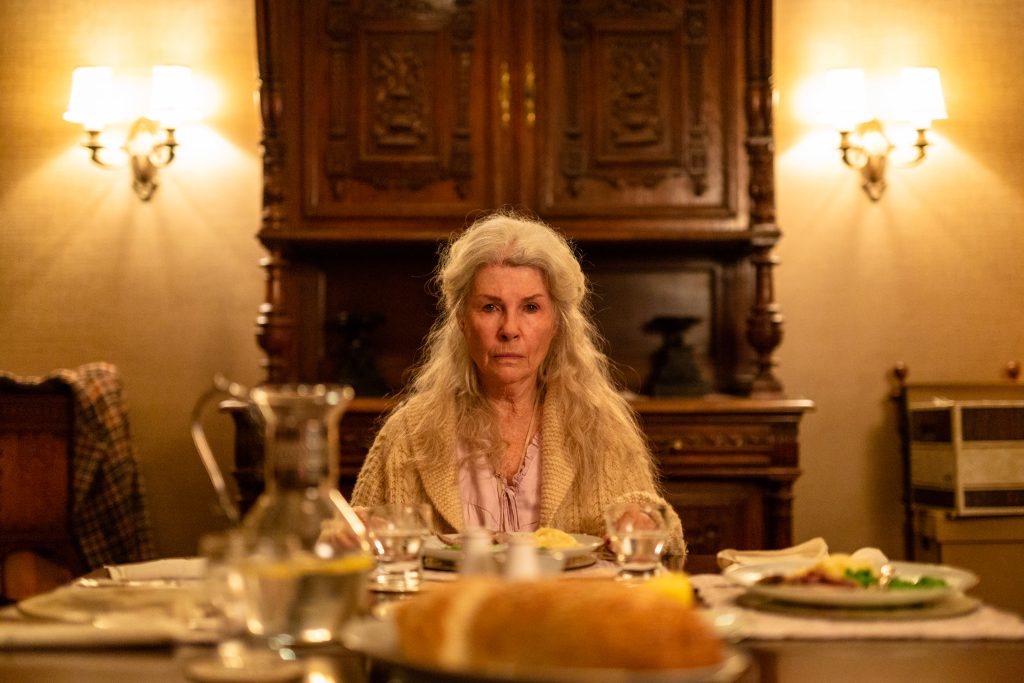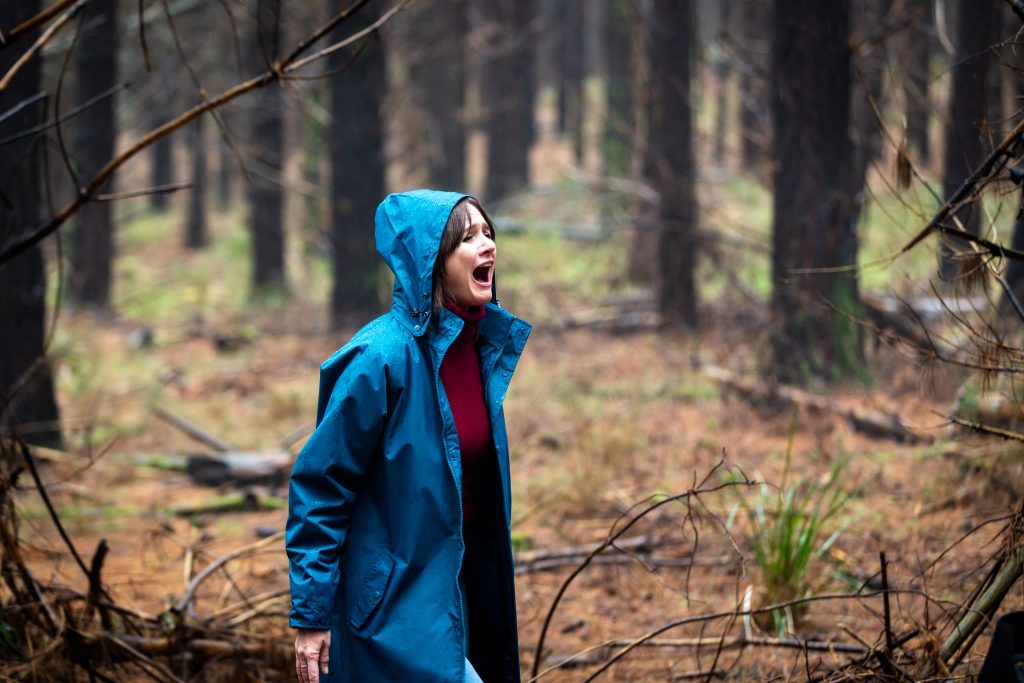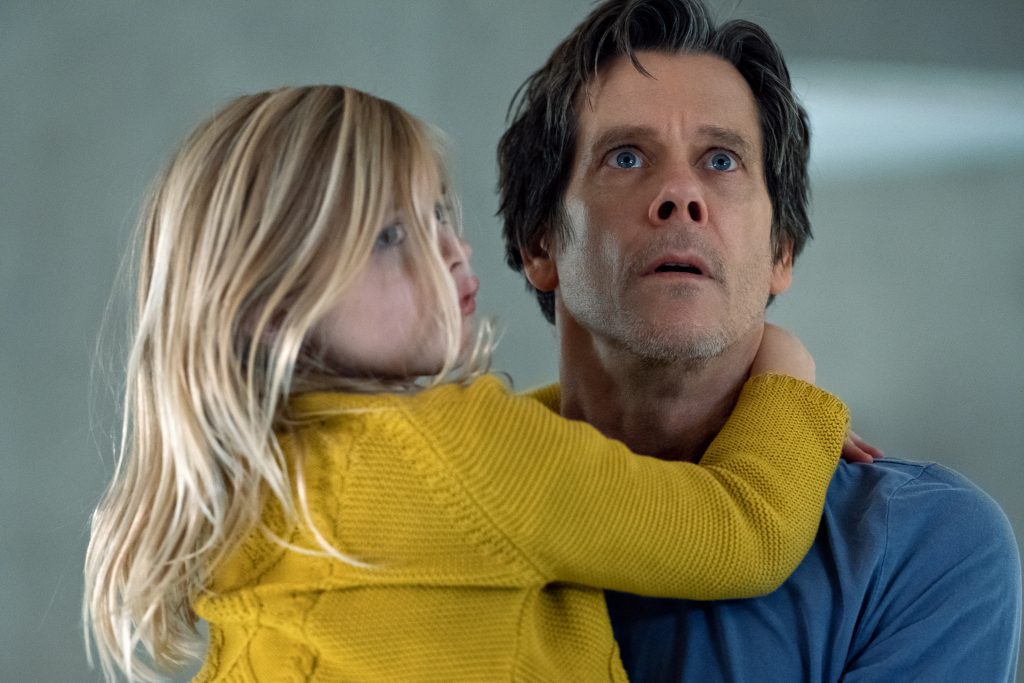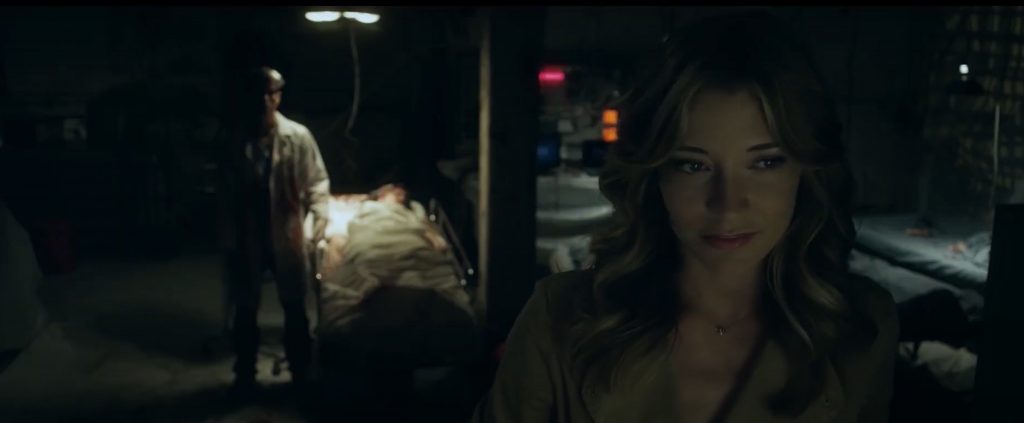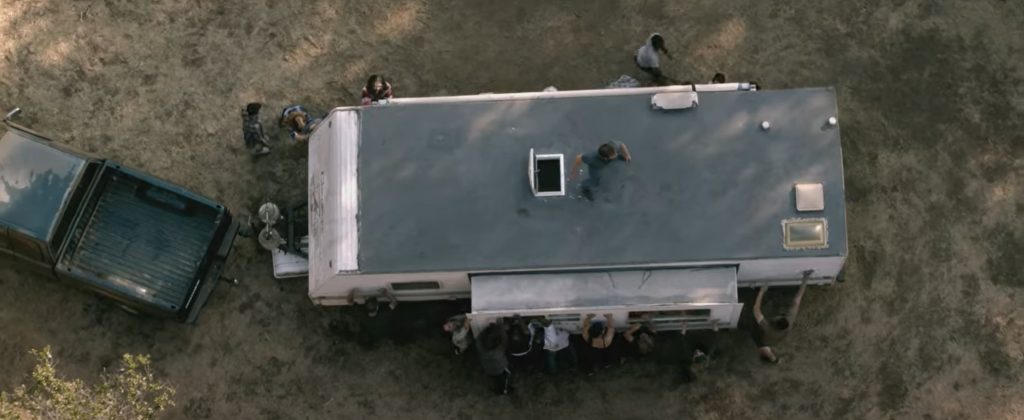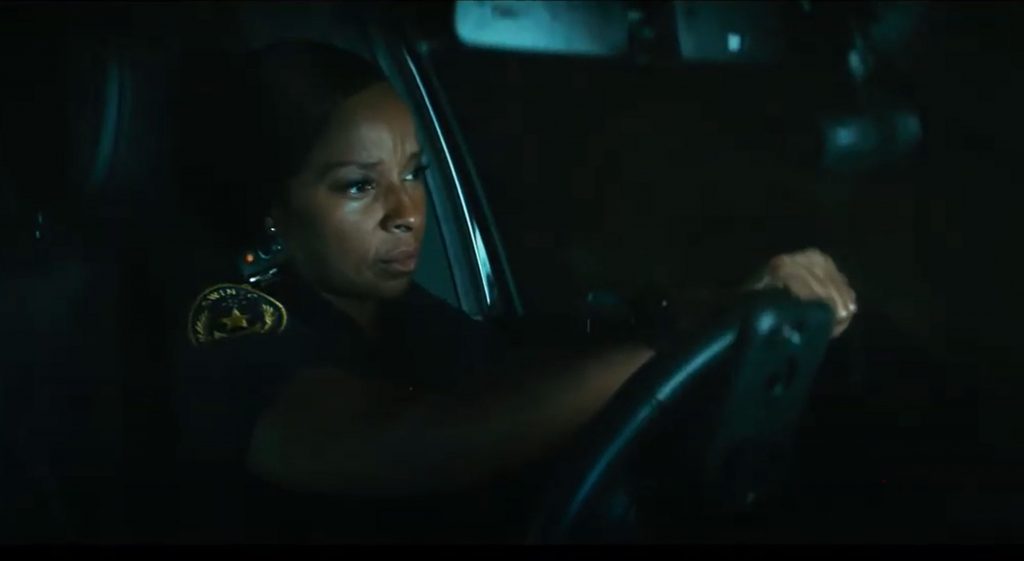July 24, 2020
by Carla Hay

Directed by Romola Garai
Culture Representation: Taking place in England and unnamed European countries in unspecified modern time periods, the horror film “Amulet” has an almost all-white cast of characters representing the middle-class.
Culture Clash: A former soldier-turned-Ph.D. philosophy student takes a job in London as a live-in handyman in a creepy house that’s occupied by a young woman and her mysterious mother, who lives as a recluse in the house’s attic.
Culture Audience: “Amulet” will appeal primarily to people who like horror movies that excel in creating a foreboding atmosphere, but makes viewers watch a lot of extremely slow-paced scenes to get to the movie’s underlying messages and plot twists.

The horror film “Amulet” (written and directed by Romola Garai) makes a bold effort to flip a lot of tropes and shatter a lot of stereotypes that are seen all too often in psychological thrillers. But in doing so, the movie’s execution falls short of being completely engaging, since it’s bogged down by extremely slow pacing. And making matters worse, several parts of the movie have dialogue and reactions that are so simple-minded, it makes you question the intelligence of the Ph. D. student who’s one of the movie’s main characters.
People who hate movies that have flashbacks that might be confusing, be warned: “Amulet” is full of these types of flashbacks. The gist of the story is that there’s a former war soldier from an unnamed continental European country who has ended up in a haunted house in London. The movie never states what war he was in, but he keeps having nightmare flashbacks to that war, where he worked for a time as a lone soldier manning a checkpoint booth on a very deserted road in a wooded area.
The former soldier’s name is Tomaz (played by Alec Secareanu), and somehow he’s ended up in England, where he’s enrolled in a doctorate program for philosophy. Tomaz (who has a beard in the present day) keeps having nightmares about his time as a soldier, when he didn’t have a beard. (It’s one of the ways that the movie distinguishes between the past and the present.)
Tomaz’s nightmares are shown as flashbacks in non-chronological order, so viewers have to piece together the puzzle of this story. It might be a challenge for viewers who have short attention spans or who are watching this often-dull movie with other distractions.
The most important things to know about the flashbacks are that while Tomaz was a soldier, he found an amulet buried in the woods, and he got to know a woman in distress whom he met when she ran to the checkpoint and collapsed in front of him. The checkpoint is located in the same wooded area where Tomaz found the amulet.
The woman’s name is Miriam (played by Angeliki Papoulia), and when Tomaz first saw her running toward the checkpoint, he yelled at her to stop and that if she didn’t stop, he was going to shoot. Just as Tomaz raised his gun to shoot her, she collapsed in front of him. It’s shown in flashbacks that after Miriam regained consciousness with Tomaz’s help, they began having conversations and he became her protector, since she apparently needed food and shelter.
Flash forward to the present day. While Tomaz has been working on his dissertation in London, he’s ended up living with some homeless people in an abandoned church. A fire breaks out at the church, so the homeless people scatter.
The next thing you know, a bloodied Tomaz is being treated at a hospital. A nurse asks him, “Who tied you up?” He replies, “Friends. It was a joke.” Tomaz then mentions that he had a bag with him but it’s now missing.
The nurse tells him that Tomaz needs to speak to the orderly, who has the bag and a message for him. While on his way to retrieve his bag, Tomas passes by a room where he sees a pregnant woman sitting on a floor, and she’s crying out in pain because she’s in labor. The only purpose of this deliberately confusing scene is to set the tone for themes of some very female-centric pain that’s shown later in the story.
Why is Tomaz homeless? The movie might answer that question, but in the meantime, Tomaz finds a new place to live when a nun from the local diocese, who knows that Tomaz was one of the squatters in the burned church, tells him about a house that needs a live-in handyman.
The nun’s name is Sister Claire (played by Imelda Staunton), and she tells Tomaz that the people in the house are offering free room and board in exchange for him doing repairs and renovations. And because this is a horror movie, you can bet that some very bad things are going to happen in this house.
The cottage-styled house looks quaint and charming on the outside, but on the inside there’s a lot of emotional rot and turmoil. There are two people who live in the house: Magda (played by Carla Juri), a woman in her 20s and her unnamed mother (played by Anah Ruddin), who lives as an ailing recluse upstairs in the attic. The mother can often be heard moaning in pain, and Tomaz tries to avoid being in contact with her as much as possible.
As Tomaz gets to know Magda, he begins to see that she is a very naïve, sheltered and passive woman. She says she hasn’t traveled outside of the city, nor does she show an interest in traveling or going outside her comfort zone. And there are signs that she doesn’t have much experience with romance or dating.
But what disturbs Tomaz the most is that Magda’s mother appears to be physically abusing Magda. (He sees Magda secretly covering her bruises and possible bite marks with bandages.) And Tomaz is also starting to get creeped out by strange things that are happening in the house.
He finds a mysterious white bat-like creature in the bathroom toilet, which is filled with a disgusting dark liquid. Tomaz kills the creature by stomping on it. Magda is there too, but she oddly doesn’t seem as frightened by this bat-like creature in the same way as Tomaz.
And when Tomaz does some ceiling repairs, he sees (or is it hallucinates?) that the ceiling has engravings that look a lot like the engravings on the amulet he found in the woods. It startles him so much that falls off a ladder while he’s looking at the ceiling. Tomaz believes that the engravings are to ward off evil spirits.
Magda doesn’t see a lot of the same things in the house that Tomaz does, so he begins to wonder if he’s going crazy. Tomaz has also seen what Magda’s mother looks like, and she’s decrepit-looking old woman who would be a stereotypical example of what a witch is supposed to look like. Is it any wonder that Tomaz thinks that maybe Magda’s mother is behind some of the eerie things that he’s experiencing in the house?
Tomaz tells his suspicions to Sister Claire and says that he thinks Magda’s mother doesn’t want him in the house. The nun replies: “What we want isn’t always what we need.” At least once during the story, Tomaz threatens to quit.
Meanwhile, the relationship between Tomaz and Magda starts to become more emotionally intimate. It’s obvious that she wants something sexual to happen between them. However, Tomaz is very resistant and tries to let Magda down easy without insulting her. (After all, she’s technically one of his bosses.)
Unfortunately, the Magda character is written in such a simple-minded way, that the conversations she has with Tomaz are excruciating to watch. Magda says things like this to Tomaz about his soldier past: “Did you kill people? It’s a sin to waste your life.” And when the emotionally stunted Magda starts to show a romantic interest in Tomaz, it’s like watching an adolescent girl trying to be sexually attractive to a grown man. Very cringeworthy.
Sister Claire is an interesting character (and Staunton is by far the best actor in this cast), but she isn’t in the movie enough to bring more energy to this often-listless story. Because “Amulet” is told from Tomaz’s perspective, he spends most of the movie being confused about what’s going on in the house while dealing with his nightmare flashbacks that appear to seep into his current life. Therefore, viewers have to figure out what might be “real” and what might be a “delusion.”
“Amulet” is the first feature film for Garai as a writer/director. She is also known as an actress who’s appeared in British TV series such as “The Hour” and the 2009 miniseries adaptation of Jane Austen’s “Emma,” which starred Garai in the title role. Most of the actors in “Amulet” are well-cast in this movie, except for Juri, who gives a very annoying performance.
Although the production design, cinematography, visual effects and cinematography suit this horror film very well, the weak links are the movie’s screenplay, editing and overall direction. The characters often speak with long pauses, which might work for a play on stage. But this is a horror movie, and lethargic dialogue and sluggish pacing are antidotes to the type of suspense that’s crucial for any good horror flick.
“Amulet” certainly deserves a lot of credit for having some twist-filled elements that add intrigue to the story. It’s too bad that these plot twists arrive so late in the film, that a lot of bored viewers might stop watching the movie before getting to the film’s shock-intended conclusion.
Magnet Releasing released “Amulet” in select U.S. cinemas, on digital and on VOD on July 24, 2020.

